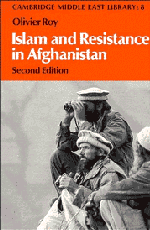Book contents
- Frontmatter
- Contents
- Acknowledgements
- Maps
- Introduction
- 1 State and society in Afghanistan
- 2 Islam in Afghanistan
- 3 The origins of Afghan fundamentalism and popular movements up to 1947
- 4 The Islamist movement up to 1978
- 5 The communist reforms and the repression, 1978–9
- 6 The uprisings, 1978–9
- 7 The establishments of political parties
- 8 The development of the parties between 1980 and 1984
- 9 The role of the Shiʿa in the resistance
- 10 Society and the war
- 11 From freedom fighter to guerilla
- 12 Military operations
- 13 The conflict from 1986 to the Soviet withdrawal
- 14 Cultural patterns and changes in society: an assessment
- 15 Afghan politics and the outside world
- Appendixes
- Notes
- Bibliography
- Index
3 - The origins of Afghan fundamentalism and popular movements up to 1947
- Frontmatter
- Contents
- Acknowledgements
- Maps
- Introduction
- 1 State and society in Afghanistan
- 2 Islam in Afghanistan
- 3 The origins of Afghan fundamentalism and popular movements up to 1947
- 4 The Islamist movement up to 1978
- 5 The communist reforms and the repression, 1978–9
- 6 The uprisings, 1978–9
- 7 The establishments of political parties
- 8 The development of the parties between 1980 and 1984
- 9 The role of the Shiʿa in the resistance
- 10 Society and the war
- 11 From freedom fighter to guerilla
- 12 Military operations
- 13 The conflict from 1986 to the Soviet withdrawal
- 14 Cultural patterns and changes in society: an assessment
- 15 Afghan politics and the outside world
- Appendixes
- Notes
- Bibliography
- Index
Summary
Afghanistan has always been at the crossroads between the Indian subcontinent, Iran and Central Asia. Although a tradition of popular uprising stems from the Iranian Khorassan, the religious currents which swept Afghanistan from the sixteenth to the twentieth century all came from India and it was in the east of the country, on the frontier, that rebellion took place. Afghanistan, on the threshold of the subcontinent, has invaded India many times. Many dynasties in northern India, including that of the Moguls (1526–1852), were founded by princes who had come from Afghanistan. The cultural similarities between the countries are very marked, and Persian was for a long time the language of the court at Delhi. Above all, until 1947 India was the main educational centre for Afghan ʿulatna; it also provided them with the opportunity of coming face-to-face with other religions (Hinduism, Sikhism, Christianity) or with heresies (the syncretism of Akbar), which acted as a stimulus to Muslim reform. There was little dispute concerning the frontier with Iran, apart from the conflict about Herat. The north of Afghanistan was disputed between the Uzbek khan and the Amirs of Kabul, but no popular religious movement (this area was Sunni) made itself felt until the arrival of the Bolsheviks. The general decay which set in during the Bukhara regime also had its effect on intellectual life.
- Type
- Chapter
- Information
- Islam and Resistance in Afghanistan , pp. 54 - 68Publisher: Cambridge University PressPrint publication year: 1990



